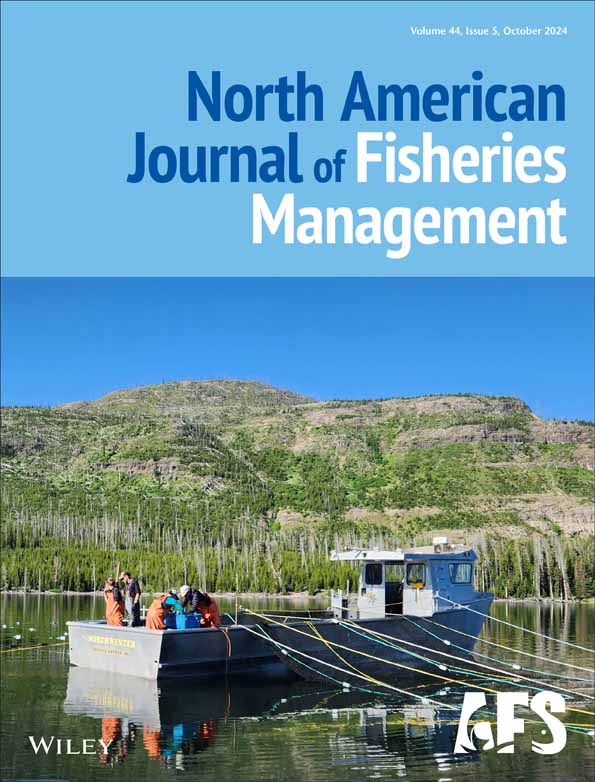Dorsal fin height is not an effective tool to distinguish hatchery and wild steelhead in the field
Abstract
Objective
To maximize harvest of hatchery steelhead Oncorhynchus mykiss and Pacific salmon Oncorhynchus spp. while reducing impacts to wild conspecifics, fishery managers rely on the ability of anglers to distinguish between the two. Fin erosion, including dorsal fin erosion, is a common result of hatchery rearing of juvenile salmonids. Since the 1980s, managers in the Pacific Northwest have utilized adult steelhead dorsal fin height as a regulatory control rule, requiring anglers to release steelhead with dorsal fins over a height threshold. This approach assumes that all or most hatchery fish have shorter dorsal fins than their wild counterparts. This study was designed to test this assumption.
Methods
We compared steelhead origin (hatchery or wild) determined using scale analysis and adipose fin clipping (hatchery n = 127, wild n = 71) with origin estimated using dorsal fin height.
Result
Overall, a static dorsal fin height threshold (2.25 in, 5.72 cm) correctly identified 90% of hatchery-origin steelhead but misidentified nearly half (44%) of wild fish as hatchery. Dorsal fin height of known hatchery fish correlated with fish length, indicating a weakness of using a static dorsal height threshold as a management tool. The accuracy of distinguishing wild fish improved, but only marginally (56–76%), using a classification model where dorsal fin height of known origin fish from this study was a continuous predictor of origin. In comparison, adipose fin status correctly identified 97% of unmarked fish as wild.
Conclusion
The low accuracy of the classification model and static dorsal fin height thresholds at distinguishing hatchery and wild steelhead due to a strong correlation between dorsal fin height and fork length and the high fork length variability of hatchery origin fish. Given the low cost and accuracy of adipose fin clipping and the potentially high conservation risk associated with misidentification, we recommend discontinuing the use of dorsal fin height as a harvest control rule for steelhead.
INTRODUCTION
For the past 100 years, fisheries managers have relied on steelhead Oncorhynchus mykiss and Pacific salmon Oncorhynchus spp. produced in hatcheries to support harvest objectives. However, there is increasing evidence that hatchery-origin fish negatively affect their natural-origin counterparts (referred to as “hatchery” and “wild” hereafter) in the marine and freshwater environments through reduced fitness (Kostow and Zhou 2006; Claussen and Philipp 2022), competition (Berejikian et al. 1996; Weber and Fausch 2003), and predation (Cannamela 1993; Hawkins and Tipping 1999) as reviewed in Naish et al. (2007). To promote conservation of wild steelhead, fisheries managers in the late 1980s began implementing harvest control rules across the steelhead range that required anglers to release wild fish caught while targeting hatchery-origin fish (referred to as “mark-selective fisheries”) (Hoffmann and Pattillo 2008). Mark-selective fisheries provide an important tool for maximizing recreational opportunity while reducing harvest and impact on wild stocks, though their successful execution requires careful estimation and monitoring of mark rates, encounter rates, and incidental hook-and-release mortality rates (Hoffman and Pattillo 2008). This strategy is particularly important for steelhead conservation in Washington, where five distinct population segments are currently listed as threatened under the Endangered Species Act (Cram et al. 2018).
While mark-selective fisheries have proven effective at achieving fisheries management objectives in many areas, successful implementation requires anglers to distinguish hatchery and wild fish in the field. Currently, mark-selective fisheries in Washington State rely, in large part, on removing the adipose fin prior to release from hatcheries to enable anglers to distinguish between wild and hatchery fish. Despite the challenge of implementing this at a large scale, Washington hatcheries regularly achieve greater than 90% accuracy at mass marking by adipose fin clipping (Regional Mark Information System, https://www.rmpc.org/). The presence or absence of an adipose fin effectively enables anglers to distinguish between hatchery and wild salmonids, and adipose fin removal results in low mortality and low rates of regrowth (Gjerde and Refstie 1988; Vander Haegen et al. 2005; Mortensen et al. 2016).
Prior to mass marking of hatchery fish through adipose fin clipping, managers implemented mark-selective fisheries by requiring anglers to measure the dorsal fin height of captured steelhead and release fish whose dorsal fin height exceeded a static threshold, referred to as a “dorsal fin height harvest control rule.” These regulations were based on the observation that steelhead, and other salmonids reared in hatchery conditions, show signs of dorsal fin erosion or “stubbing” (Latremouille 2003). Previous studies comparing hatchery and wild salmonids identified that, relative to body length, hatchery fish had significantly shorter dorsal fins, likely due to rearing density, aggressive behavior, nutrition, and water quality effects in conventional hatcheries (Bosakowski and Wagner 1994; Berejikian and Tezak 2005; Kavanagh and Olson 2014). How dorsal fin height varies with age, determined using scale analysis, and sex has not been specifically compared, however, between hatchery and wild steelhead.
Dorsal fin height harvest control rules for steelhead have been implemented in multiple states with varying height thresholds. A dorsal fin height harvest control rule was first implemented on the Salmon River in Idaho in 1982 (Thurow 1985) and required anglers to release steelhead with dorsal fin heights greater than 57 mm (2.24 in). A similar rule was soon implemented in Washington State that required anglers to measure and release steelhead whose dorsal fin height exceeded the width of an agency-issued, credit-card-sized plastic measuring device (2.25 in) (Figure 1). Dorsal fin height harvest control rules were suspended on most Washington rivers by the early 2000s, successfully replaced by adipose fin presence/absence rules. Despite the success of adipose fin clipping, steelhead harvest management on some Washington coast rivers still relies on a dorsal fin height harvest control rule, such as in the Queets, Clearwater, and Salmon rivers, where anglers are permitted to retain winter steelhead with a dorsal fin height less than 2.125 in (54 mm) due to the lack of adipose fin removal. In some instances, this dorsal fin height harvest control rule has been used as an emergency management tool, such as in the Hoko River, Washington, when hatchery steelhead smolts were released without adipose fin removal in the spring seasons of 2016 and 2017.

The effectiveness of dorsal fin height as a harvest control rule for steelhead has not been evaluated for Washington coast populations. DeShazo (1985) compared estimates of dorsal fin height for hatchery and wild steelhead from select populations in Idaho, Oregon, and the Columbia River and reported a high degree of variation and overlap in dorsal fin heights between hatchery and wild groups. DeShazo (1985) cautioned that using static dorsal fin thresholds as a harvest control rule, given previously observed variability in dorsal fin heights, may cause unintended consequences to natural populations because it would allow harvest of wild fish with small dorsal fins and require release of hatchery fish with large dorsal fins into the wild. It is now prudent to revisit this topic because hatchery practices have improved over the past 40 years, resulting in highly accurate adipose fin removal of hatchery steelhead released in Washington (Regional Mark Information System), and conservation concern for Washington's wild coastal steelhead has increased.
Here, we evaluated the accuracy of using dorsal fin height to distinguish hatchery and wild steelhead in a coastal Washington population, Fork Creek, using two approaches. First, we evaluated the accuracy of using a static dorsal fin height harvest control rule to distinguish between the two groups. Second, using adipose fin clip status and scale analysis, we assessed the accuracy of a logistic classification model that assigned steelhead to either hatchery or wild origin using dorsal fin height as a continuous variable predictor. We additionally explored the relationships between fish length, age, and sex to dorsal fin height to improve our understanding of the factors influencing the effectiveness of the dorsal fin height harvest control rule. This study provides critical data for fisheries managers designing harvest control rules for steelhead.
METHODS
Steelhead collection and sampling
Adult winter-run steelhead were intercepted during their upstream spawning migration in Fork Creek, a tributary of Willapa River, Pacific County, Washington, between January 1 and June 30, 2021. Here, the Washington Department of Fish and Wildlife operates a permanent weir used for hatchery operations at Forks Creek Hatchery. Hatchery steelhead are produced from a segregated broodstock (i.e., only hatchery-origin fish are used as broodstock) originally derived from Chambers Creek stock in Puget Sound. Steelhead collected were identified in the field as hatchery or wild based on adipose fin status (clipped versus unclipped). Sex of wild and hatchery fish was determined primarily based on the presence (male) or absence (female) of a kype as well as the presence (female) or absence (male) of an ovipositor. Fish were anesthetized with tricaine methane sulfonate (MS-222; 70 mg/L), and their fork length and dorsal fin height (mm) from the base to the dorsal tip were measured using a transparent ruler (Figure 2). To determine the age of each fish, scales from the preferred area (posterior to the dorsal fin and approximately four scale rows above the lateral line; Davis and Light 1985) were removed. Adipose-clipped hatchery fish were used as broodstock or euthanized, allowing a secondary verification of sex by visually inspecting gonads, while fish with intact (unclipped) adipose fins were released upstream after a 10-min recovery period.
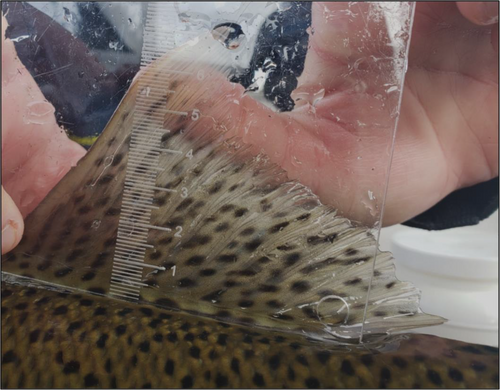
Scale analysis
Scale analysis accurately assigns steelhead age (Seamons et al. 2009) and origin (hatchery versus natural) (Bernard and Myers 1996) because consistent growth in the hatchery setting leads to consistent circuli spacing, younger age at out-migration (age 1), and larger freshwater size not typically observed among naturally produced fish (Bernard and Myers 1996). Hatchery steelhead in this study were produced in brood years 2017 and 2018, and 99% of juvenile steelhead from those brood years were marked by adipose clip, resulting in either completely absent adipose fins or adipose fins with signs of mechanical clipping that have experienced some regrowth (Regional Mark Information System). Because a small proportion of hatchery steelhead were unintentionally not physically marked prior to release, we also used scale analysis to identify any unmarked hatchery fish independent of dorsal fin height or adipose fin clips.
Acetate impressions of each scale card were made using a heated hydraulic press for approximately 1 min. Acetate impressions were viewed using a digital microscope camera (e.g., Leica S9i) at a magnification of 6.3× to 20×. Age was designated using the European age notation described in Koo (1962) and adapted for winter steelhead (Washington Department of Game 1978). In the notation we used, numbers and symbols to the right of the decimal point indicate years or the number of winter annuli formed at sea, hereafter referred to as “marine age.” Origin of unmarked fish was determined based on the age (hatchery fish only released as age 1) and size of the freshwater zone of each scale (Bernard and Myers 1996). In our present study, the scale size of the freshwater zone of adipose-clipped hatchery fish (N = 127) was on average 1.12 ± 0.16 mm (mean ± SD) compared with 0.77 ± 0.12 mm for unclipped wild steelhead (N = 71).
Statistical analysis
We implemented a one-way ANOVA, followed by Fisher's protected least-significant-difference post hoc test (R Development Core Team 2021) to assess the difference in dorsal fin height between male and female steelhead. Similarly, we used a one-way ANOVA to assess differences in dorsal fin height between hatchery and wild steelhead. An ANCOVA was used to test the effect of length on variability in dorsal fin height while controlling for origin (hatchery versus wild). We were also interested in comparing the relationship between fish length and dorsal fin height between hatchery and wild steelhead, so we included an interaction term (origin × length). To further describe the relationship between dorsal fin height and steelhead length for both hatchery and wild steelhead, we used Pearson correlation. To compare dorsal fin height between ages for hatchery and wild steelhead, we used Kruskal–Wallis comparison of ranks due to lack of normal distribution and small sample sizes followed by pairwise comparison using Dunn's post hoc test.
RESULTS
In 2021, we sampled adipose fins, scales, and dorsal fin height from 268 steelhead. Of the 143 scales sampled from fish with intact adipose fins, 70 individuals had partially regenerated scales (in freshwater zone) precluding the determination of freshwater annuli and origin and were removed from the sample. This resulted in a total sample size of 198 steelhead (125 adipose fin clipped, 73 adipose fin intact). Of those with an adipose fin intact, 2.7% were determined to be hatchery origin based on scale patterns (2/73). Assignment of origin from scale analysis resulted in a data set including 127 hatchery-origin and 71 wild steelhead for comparison of dorsal fin height (Table 1).
| Origin | N | Dorsal fin height cutoff (in) | |||
|---|---|---|---|---|---|
| 2.0 | 2.25 | 2.5 | 2.75 | ||
| Hatchery | 127 | 76.6% | 89.5% | 96.0% | 99.2% |
| Wild | 71 | 91.9% | 56.8% | 35.1% | 16.2% |
Wild steelhead had significantly greater mean dorsal fin height (range = 3.2–7.5 cm, mean ± SD = 5.96 ± 0.83) than hatchery steelhead (range = 0.0–7.3 cm, mean ± SD = 4.19 ± 1.32) for both males and females (ANOVA: F = 74.1, df = 1, p < 0.0001, Fisher's post hoc test; Figure 3). Mean dorsal fin height did not differ between males and females for hatchery or wild steelhead (ANOVA: F = 4.8, df = 1, p > 0.05; Figure 3). Dorsal fin height was significantly related to fish length for hatchery and wild steelhead (ANCOVA: F = 65.8, df = 1, p < 0.0001). The reaction term (origin × length) was not significant (ANCOVA: F = 0.3123, df = 1, p > 0.05), revealing no difference in slopes between hatchery and wild steelhead for the relationship between fish length and dorsal fin height. Correlation analysis showed significant positive correlation between dorsal fin height and fish length for both wild and hatchery steelhead (wild: r = 0.856, p < 0.001 and hatchery: r = 0.727, p < 0.001; Figure 4). Further, dorsal fin height significantly increased with fish age for both wild and hatchery steelhead (Figure 5). Specifically, hatchery and wild steelhead that spent 3 years at sea (marine age 3) had significantly greater dorsal fin height than steelhead that spent 1 or 2 years at sea (marine age 1 and 2) (p < 0.01; Figure 5).
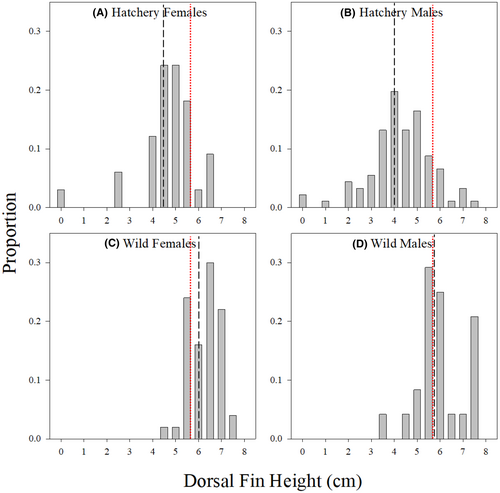
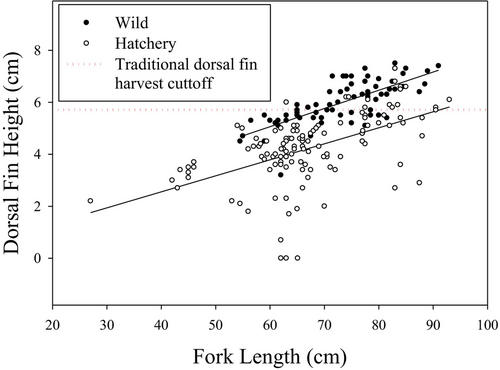
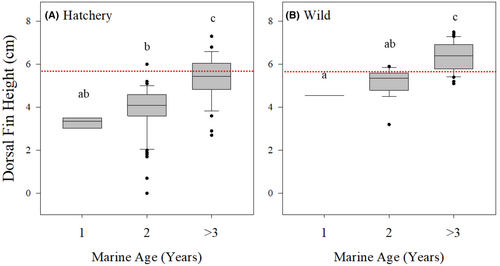
Neither the static dorsal fin height harvest control rule nor the classification model demonstrated high accuracy at identifying wild steelhead. The 2.25-in dorsal fin height harvest control rule correctly identified 90% of known hatchery steelhead (114 of 127) but only 57% of wild steelhead (40 of 71; Table 1). Using the classification model with a probability cutoff of 0.5, 88% of hatchery steelhead and 76% of wild steelhead were correctly identified. The two steelhead that had intact adipose fins but were identified as hatchery origin using scale analysis were correctly classified as hatchery fish using the classification model and the 2.25-in dorsal fin height harvest control rule. Using either the static rule or the classification model would result in misidentification and inappropriate harvest of wild steelhead and the release of otherwise harvestable hatchery steelhead. Evaluation of the static dorsal fin height at a range of fin heights demonstrated increasing accuracy for hatchery fish as dorsal fin height decreased and vice versa for wild fish (Table 1).
DISCUSSION
Dorsal fin height has been previously used and still is occasionally used in Washington State as a harvest control rule to distinguish wild and hatchery steelhead in the field. Our analysis assessed the ability of the static dorsal fin height harvest control rule and a classification model to correctly identify steelhead origin and assessed relationships between origin, age, sex, and length. We showed that while hatchery steelhead have shorter dorsal fins than wild steelhead, dorsal fin height was correlated with age and body length, which were both highly variable in these populations. This variability caused significant overlap in dorsal fin height distributions among hatchery and wild steelhead, which limited our ability to correctly identify origin based on either a static dorsal fin height or a classification model. Misidentification was higher for wild fish than hatchery fish when using either the dorsal fin height harvest control rule or the classification model. Our work shows that dorsal fin height is not an effective tool for distinguishing hatchery and wild steelhead in the field and has significant conservation and management implications.
Hatchery and wild fish are impacted differently by the observed failure of the dorsal fin height harvest control rule. Because dorsal fin growth is positively correlated with body length and age in steelhead, longer, older hatchery steelhead have taller dorsal fins, despite fin erosion. More than 10% of hatchery steelhead sampled for this study in Fork Creek, a tributary of the Willapa River, Washington, which are intended for harvest, had dorsal fin heights greater than 2.25 in and would have been released by anglers if the dorsal fin height harvest control rule was in effect. Alternatively, nearly half (43%) of sampled wild steelhead, which are illegal to harvest in the Willapa River, had dorsal fin heights that would permit harvest. Most of these wild fish were marine age 1 or 2, which are the most frequent marine ages in Fork Creek. Other rivers also support wild steelhead that normally return to freshwater at smaller average sizes and ages (e.g., summer steelhead or “half pounders”) (Hodge 2010). Harvest of these fish could impact the population and reduce life history diversity. Life history diversity is important for maintaining population stability and resiliency in wild steelhead (Moore et al. 2014; Kendall et al. 2015; Copeland et al. 2017; Dobos et al. 2020). Over time, this could decrease population diversity and stability, negatively affecting the future of wild steelhead.
Mark-selective fisheries are important for federal, state, and tribal governments to achieve a balance between harvest and conservation objectives, but dorsal fin height harvest control rules are unreliable. Alternatives to quantifying the degree of fin erosion have been proposed to support mark-selective fisheries, such as the “fin index,” which evaluated dorsal fin length relative to fish body length (Kindschi 1987; Ellis et al. 2009). However, such indices require greater measurement accuracy of anglers, who have demonstrated inaccuracies when measuring fish size in the field (Losee et al. 2023). A more complicated harvest control rule would also require increased handling of fish by anglers, which could have significant negative impacts on survival (Twardek et al. 2018, 2019).
On the other hand, the mass marking via adipose fin clipping that was introduced in the 1990s is an accurate method to distinguish hatchery and wild fish. Adipose fin clipping has become the standard for steelhead and Pacific salmon fisheries on the West Coast, with over 18 million steelhead adipose fin clipped and released each year versus approximately 2.6 million released with adipose fins intact (Regional Mark Information System, average: 2012–2021). The high rate of marking and ease and accuracy of adipose fin clipping to identify hatchery and wild steelhead in the field, as shown here, is superior to naturally occurring variation in dorsal fin height between hatchery and wild steelhead.
Our analysis of dorsal fin height as a regulatory tool for fisheries managers revealed the shortfalls of using dorsal fin height as a distinguishing method. Our data suggest that this rule is likely to allow overharvest of small, wild steelhead and unintended release of large adult hatchery fish. Given that over 30,000 hatchery steelhead annually return from state, federal, and tribal facilities on the Washington coast (Regional Mark Information System), these results suggest that the dorsal fin harvest control rule results in many mature hatchery-origin fish being released back into the environment by sport anglers. These hatchery fish are intended to support harvest, and genetic introgression between hatchery and wild fish presents a conservation risk (Kostow 2009; Cram et al. 2018). Thus, it is clear that harvest regulations relying on dorsal fin height are unlikely to support management objectives associated with harvest and conservation. These risks likely outweigh any previously reported benefits in efficiency or cost when comparing the use of dorsal fin height to adipose fin clipping, especially if public outreach and education is sufficient to inform stakeholders. To achieve harvest and conservation goals, fisheries managers should prioritize tools that provide efficient and accurate identification of hatchery and wild steelhead and Pacific salmon origin in the field, like adipose fin clipping, and discontinue methods that are prone to misidentification of origin, like dorsal fin height.
ACKNOWLEDGMENTS
This study would not have been possible without the field and analytical support of Randy Cooper, Amy Edwards, Lyle Jennings, Jessica Pease, and Nick Vanbuskirk, fruitful conversations with Sam Brenkman and Curt Holt, and review of an earlier version by Phil Sandstrom and Megan Wusterbarth.
CONFLICT OF INTEREST STATEMENT
The authors have no conflicts of interests.
ETHICS STATEMENT
There were no ethical guidelines applicable to this study.
Open Research
DATA AVAILABILITY STATEMENT
The data presented are available upon request.



